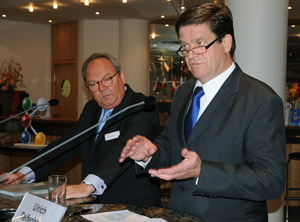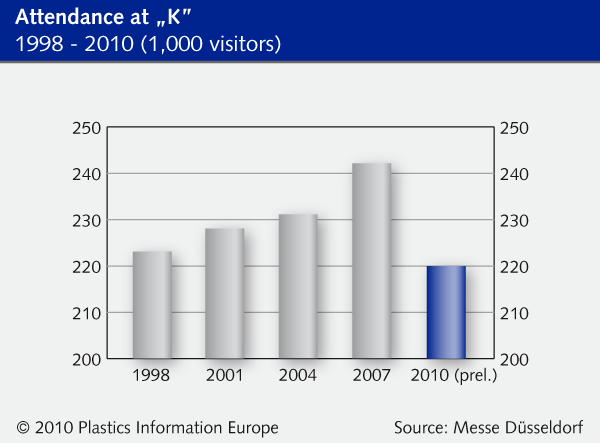K 2010
Düsseldorf asserts its role as plastics industry magnet / Visitor numbers “exceed expectations” / Optimism all round / Eight-day fair provides “new impetus” to industry
At the strike of midnight, it was all over. Three years of meticulous planning and frantic scrambling to make sure everything looks “just so” for the tens of thousands of visitors that walked the "K" beat for the past eight days.
 "We are very satisfied that the trade fair succeeded in providing strong impetus for further growth." Ulrich Reifenhäuser (right), chairman of the K 2010 Exhibitor Council, and Werner Matthias Dornscheidt (left), CEO and president of Messe Düsseldorf (Photo: PIE) |
Although the visitor numbers were down 9% over boom year 2007, the triannual plastics mega show continues to set our industry’s trends, and not just in terms of the new products, machines, processes or materials showcased here. For eight days now, Düsseldorf has been abuzz as visitors and exhibitors from all over the world used this once in three years opportunity to make new contacts and strike new business deals. As Ulrich Reifenhäuser, chairman of K 2010’s Exhibitor Council, put it: “K 2010 was held at the right point in time and has provided all areas of our industry with new impetus.” The fair clearly illustrated the positive market mood and the sense of optimism was palpable in every corner of the 19 halls.
Eight days a week – that is how long the 3,102 exhibitors from 56 different countries manned their booths and showcased their products for the more than 220,000 visitors from all over the world – a figure that “exceeded expectations in the sector,” according to Werner Matthias Dornscheidt, CEO and president of fair organiser Messe Düsseldorf.
Visitors from more than 100 different countries flocked to the banks of the Rhine river to attend the fair. Of these, close to 60% came from outside Germany. Compared to K 2007, the share of overseas visitors from beyond Europe increased to 46% of all international visitors. Whereas three years ago, 57% of all foreign guests still came from Europe, that percentage has decreased to 54%. The largest proportion, some 30,000 foreign visitors, came from Asia, with India accounting for 11,000 guests alone. Messe Düsseldorf also registered an increase in visitor numbers from Turkey, Israel, Egypt, Brazil and the United Arab Emirates. Some 10,500 guests came from Latin America, while 6,800 Canadians and North Americans crossed the Atlantic to see what the show had on offer.
Eight days a week – that is how long the 3,102 exhibitors from 56 different countries manned their booths and showcased their products for the more than 220,000 visitors from all over the world – a figure that “exceeded expectations in the sector,” according to Werner Matthias Dornscheidt, CEO and president of fair organiser Messe Düsseldorf.
Visitors from more than 100 different countries flocked to the banks of the Rhine river to attend the fair. Of these, close to 60% came from outside Germany. Compared to K 2007, the share of overseas visitors from beyond Europe increased to 46% of all international visitors. Whereas three years ago, 57% of all foreign guests still came from Europe, that percentage has decreased to 54%. The largest proportion, some 30,000 foreign visitors, came from Asia, with India accounting for 11,000 guests alone. Messe Düsseldorf also registered an increase in visitor numbers from Turkey, Israel, Egypt, Brazil and the United Arab Emirates. Some 10,500 guests came from Latin America, while 6,800 Canadians and North Americans crossed the Atlantic to see what the show had on offer.
 | |
As far as their primary interests were concerned, roughly two-thirds of the visitors mostly wanted to find out about machinery and equipment building. An increasing number of guests – 48% in total – were primarily interested in raw materials and auxiliaries, while 26% wanted to see the latest innovations in semi-finished products, technical plastics and rubber components. At 62%, most guests held top and middle management positions.
For those of us who were part of the statistics listed above, the event proved that the light at the end of the tunnel that was the crisis of 2008 is steadily getting bigger and the plastics industry in many ways is leading the way. According to Chinese tradition, the number “eight” is considered lucky because of its association with prosperity, wealth and fortune. As the plastics industry bids farewell to Düsseldorf after eight days of networking and showcasing, it is hard to believe there ever was a downturn, proving that Chinese wisdom applies here as well.
May we all be wealthier and more fortunate when we meet again in three years’ time to complete yet another lucky cycle of eight days in Düsseldorf. See you there!
04.11.2010 Plasteurope.com [217713-0]
Published on 04.11.2010

 German version of this article...
German version of this article...